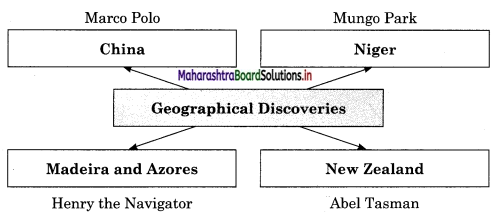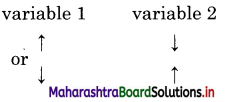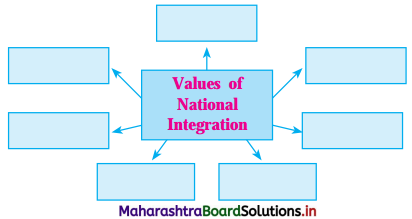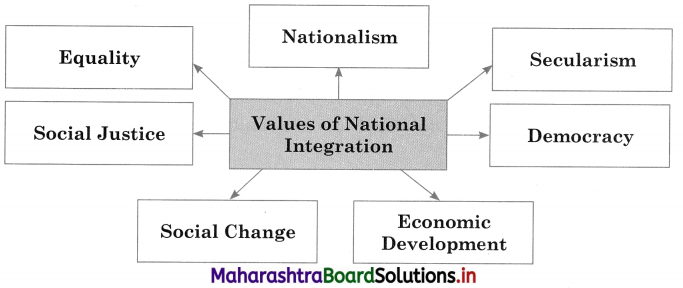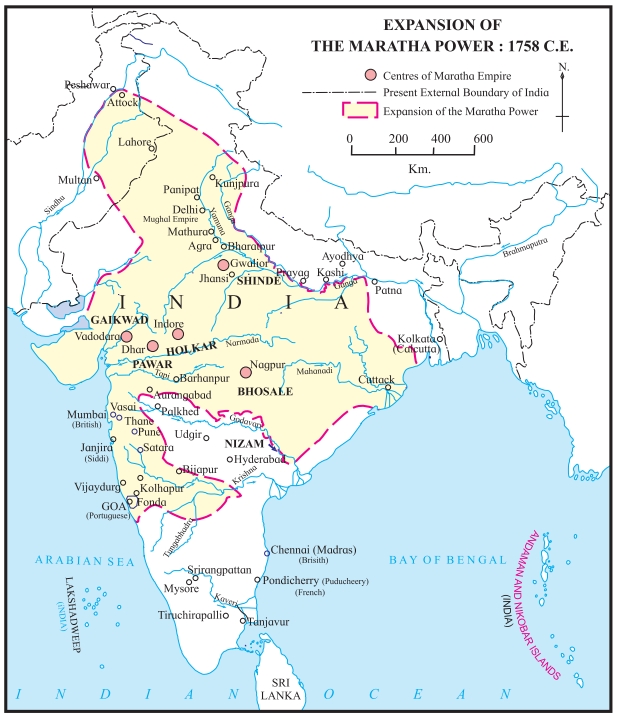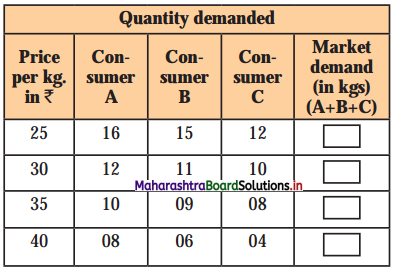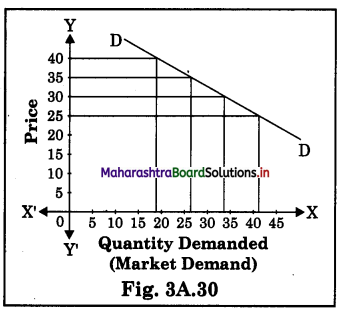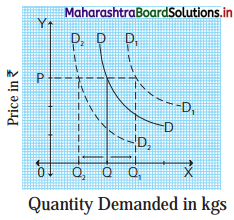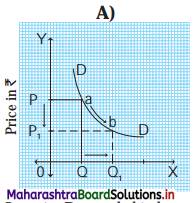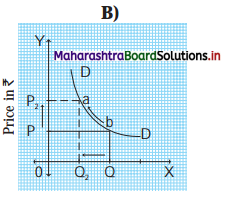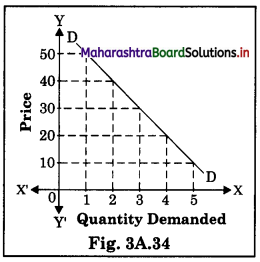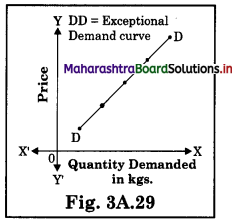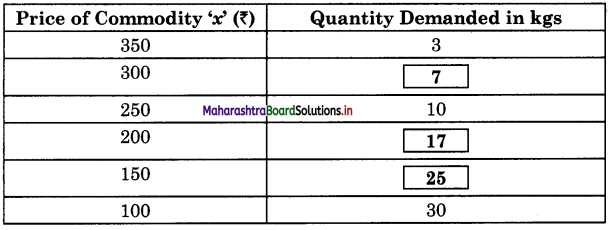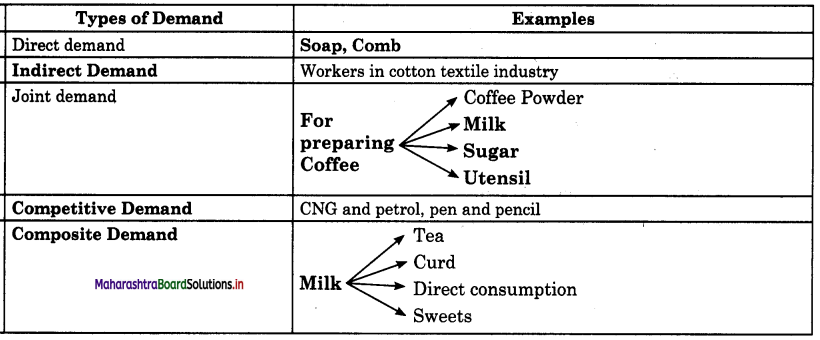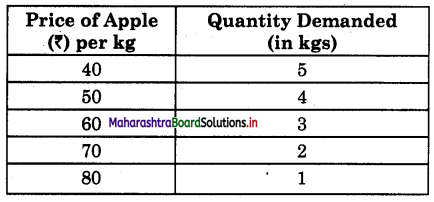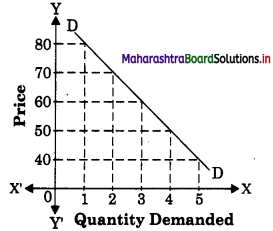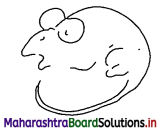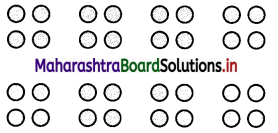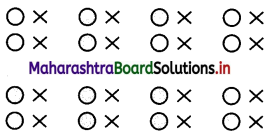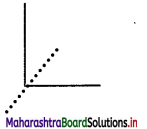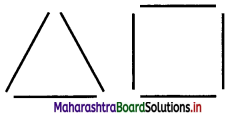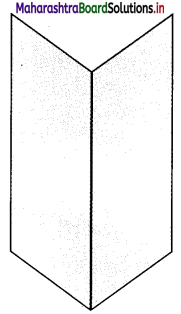Balbharti Maharashtra State Board Class 12 Sociology Solutions Chapter 3 Diversity and Unity in Indian Society Textbook Exercise Questions and Answers.
Maharashtra State Board Class 12 Sociology Solutions Chapter 3 Diversity and Unity in Indian Society
1A. Complete the following statements by choosing the correct alternative given in the brackets and rewrite it.
Question 1.
Gender is __________ (innate, genetic, learnt)
Answer:
learnt

Question 2.
Social disparity encourages __________ (unity, divisiveness, homogeneity)
Answer:
divisiveness
1B. Correct the incorrect pair and rewrite it.
Question 1.
(a) Conflict based on language – Linguism
(b) Conflict based on religion – Terrorism
(c) Conflict based on caste – Casteism
(d) Conflict based on region – Regionalism
Answer:
(b) Conflict based on religion – Communalism
1C. Identify the appropriate term from the given options in the box and rewrite it against the given statement.
Totalitarianism, Class, Egalitarianism
Question 1.
It is an achieved status.
Answer:
Class
Question 2.
Promotes healthier relationships.
Answer:
Egalitarian society
1D. Correct underlined words and complete the statement.
Question 1.
Conflict based on caste is called communalism.
Answer:
Conflict based on caste is called casteism.
Question 2.
Saravadharmasamabhav denotes the Indian concept of unity amidst diversity.
Answer:
Saravadharmasamabhav denotes the Indian concept of secularism.
2. Write short notes.
Question 1.
Gender Diversity.
Answer:
Gender diversity is linked to the notion of ‘gender’ (a social construct), which in turn is related to concepts such as gender binary, gender expression, sexuality, and sexual orientation. Gender includes diversities that go beyond gender binaries of female-male, feminine-masculine, her- his, etc. Today, our understanding of gender diversity also includes the sexual orientation of people.
The acronym ‘LGBT’, Lesbian: Female-Female relationship, Gay: Male-Male relationship Bisexual: People who are attracted to two sexes (namely, Female and Male) Transgender: A person whose biological sex does not match one’s psychological sense of self emphasize the diversity of sexuality and gender identity.
There are individuals, groups, and societies that have challenged the notion of a binary and thus are more inclusive of sexual and gender pluralities. Most of us are coerced into conformity to follow the expectations of gender-linked to one’s sex known as gender expression linked to gender socialization also leads to diversity.
Today, societies are gradually opening up to understanding and accepting gender fluidity i.e. understanding that gender is not limited to binary and not necessarily tied to physical appearance or characteristics. One’s sexuality and helps us to understand the sexual orientation of a person is not a preference. Historic judgment of the Supreme Court of India on 6th September 2018 decriminalized homosexuality. The Government of India has also recognized transgender people and their rights.

Awareness about and sensitivity to diversities based on gender will help:
- dispel ignorance and myths related to gender
- restore dignity to people with different gender identities
- eradicate hate, violence prejudice, and discrimination towards gender non-conforming individuals
- promote equality and justice as enshrined in the Indian Constitution.
Question 2.
Importance of Unity in Diversity
Answer:
India is a country whose society is united in diversity. The religions language, culture, etc. everything differs yet the people of our country are untied. The significance of unity in diversity is necessary for peaceful coexistence with different groups and diverse cultural backgrounds. It improves healthy human relationships and protects equal human rights for all.
According to D.P. Singhal, in his book- “India and World Civilizations” unity in diversity is a theme that runs through the entire course of Indian history. Though there is so much diversity in India along lines of region, language, religion, caste, etc., there are cross-cutting solidarities that help us as a nation to combine and recombine. India has always assimilated cultures that it came into contact with and at the same time has retained the essentials of its own.
Indians today, despite their differences, have adapted to political democracy, which indicates the underlying unity in diversity. One important point is that the Indian people have never regarded diversity as a problem but more as a treasure to be cherished. The inner strength of India lies in our ability to accommodate variety and multiplicity within the framework of a larger unity. It is the sign of a healthy organism that the processes of integration and differentiation go on side by side.
The underlying unity in diversity has created a composite culture decisively pan-Indian in nature. Unity amidst diversity can be seen in the geopolitical sphere, institution of pilgrimage, tradition of accommodation, the tradition of interdependence, emotional bonding, etc. Given the nature of our religious plurality, the concept of secularism in India fosters a modern outlook showing religious tolerance. In India, secularism implies respect and tolerance for people of all faiths, beautifully encapsulated in the term, ‘sarvadharmasamabhav’. India has been and continues to be a land with multiple faith systems. This necessarily includes acceptance of people who do not subscribe to any religious identity, custom or practice, but who may express their loyalty and commitment to secular values such as scientific endeavor, humanitarianism, humanism, and so forth.
Need for unity
- To strengthen and enrich our cultural Heritage
- To protect the multiple diversities of
- To protect the Human Rights of all Indian society citizens.
- To boost workplace, organizational, and community morale.
- For effective and inclusive Communication.
- For conflict resolution.
- For peaceful coexistence.
- For the welfare of all people irrespective of caste, creed, sex, gender, race, economic class, culture etc.
- For the prosperity of our land and its people.
3. Write differences.
Question 1.
Regionalism and Linguism
Answer:
| Regionalism |
Linguism |
| (i) Meaning: Regionalism refers to loyalty to one’s own State or region before one’s nation. |
(i) Meaning: Linguism is a form of excess loyalty towards one’s own language. |
| (ii) Causes: Regionalism emerges due to the desire of people speaking one language to have one State. Differences in states and regions create the problem of regionalism. |
(ii) Causes: Differences in State and regions creates the problem of regionalism linguism emerges if the minorities begin to feel that their interests are being disregarded and their welfare ignored. |
| (iii) Origin: It was developed by the British government. |
(iii) Origin: It develops from the idea of separation and division of people on the basis of language. |
| (iv) Impact: Regionalism is a divisive force that creates disrespect for people from other regions of the same country. |
(iv) Impact: Linguism has led to a definite form of linguistic nationalism which can provide enough fuel for separatism in India. |
| (v) Example: Regionalism has led to regional movements for State rights and militant movements for separatism. For example, the Jammu and Kashmir issue, the Punjab problem, Assam issue, etc. |
(v) Example: Linguism has led to the unacceptance of Hindi as an official language of the Union across the country. For example, the atrocities committed on linguistic minorities. |
Question 2.
Casteism and Communalism
Answer:
| Casteism |
Communalism |
| (i) Meaning: Casteism refers to loyalty to One’s own caste before loyalty to the nation. |
(i) Meaning: Communalism refers to loyalty to one’s own religion before the nation. |
| (ii) Manifestations: Caste ties may lead to caste members protecting their own caste group through social service, education, medical and other welfare schemes. |
(ii) Manifestations: Religious fundamentalists try to impose their religious practices on others, which leads to communal conflict and antagonism between members of different religious communities. |
| (iii) Effects: Caste conflict has led to caste and Caste prejudices. |
(iii) Effects: Religious fundamentalism can lead to, acts of terrorism which can create a fear psychosis in the minds of people. |
| (iv) Impact: Casteism leads to excessive caste-based loyalty, particularly evident at the time of elections. |
(iv) Impact: Communal conflict weakens democracy, for example, Mumbai riots, etc. riots during India Pakistan partition. |
4. Explain the following concepts with examples.
Question 1.
Heteronormativity
Answer:
Heteronormativity:
The belief is that people fall into distinct and complementary genders (man and women) with natural roles in life.
It assumes the heterosexuality is the only sexual orientation or only norm and states that sexual and marital relations are most fining between people of the opposite sex. Heteronormativity is an assumption that all people are straight and only a normal and natural expression of sexuality.
What constitutes appropriate behaviour for girls/women and boys/men is a result of social conditioning, indoctrination, and cultural definitions. Hence, there is variability between societies, as well as within groups in a specific society. This leads us to understand the dominance of ‘heteronormativity’ (that is the norm that reinforces and ‘normalizes’ the gender binary) in society and in all its institutions such as family, marriage, polity, economy, religion, etc.
Example: Marriage between men and women gives them social recognition and support for an intimate relationship i.e., socially and legally approved in our society.

Question 2.
Communalism
Answer:
Communalism:
Communalism refers mainly to loyalty to one’s own religion before the nation. It implies extreme pride in and identification with one’s own religion. India is one of the countries in the world where so many religions co-exist side by side. Communal conflict is a displeasing factor that affects the unity of the nation.
Socially, communal conflict creates feelings of deep hatred, bitterness, and antagonism between members of different religious communities. Such conflicts also lead to feelings of insecurity and they loosen bonds of solidarity. Economically, communal conflicts retard economic growth and development. Often, resources have to be diverted for the damage caused by communal riots and clashes. Production suffers and there is a severe monetary loss for the nation. Politically, communal conflict weakens democracy. It allows politicians to use religion as a means to acquire positions of prominence for their vested interests.
Also, on the international front, communal conflict affects India’s image adversely and weakens it considerably. Religious antagonism has posed a serious challenge to national integration in India. People belonging to different religions feel that their religion is superior; this is a problem of enhanced ethnocentrism.
Political manipulation is often known to project one religion against the other which has resulted in communal riots, mutual distrust, and disintegration. Large-scale illiteracy and superstitions are responsible, along with other causes for the rise of communal violence and divisive tendencies in the country. Religious fundamentalism can lead to acts of terrorism which can create a fear psychosis in the minds of people. Communalism is a severe threat to the harmony and secular spirit of a country.
Example: Incidence of communal riots.
The Ram Mandir -Babari Masjid issue in the year 1990, Mumbai riots in 1992 & Godhra riots in 2002, the partition riots of 1947 – the worst incident of Hindu Muslim conflict in the history of India.
5A. Complete the concept map.
Question 1.
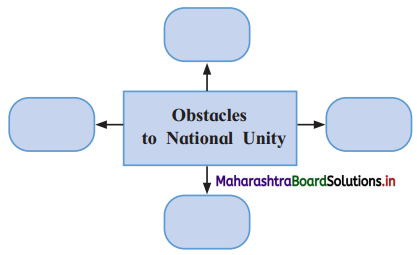
Answer:
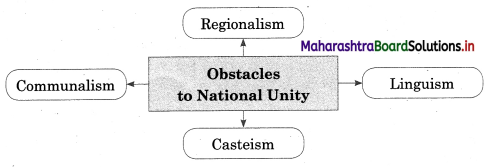
B. State whether the following statements are True or False with reasons.
Question 1.
Economic inequality has no effect on society.
Answer:
This statement is False.
Economic inequality has an adverse effect on society. A high level of economic inequality means a high level or poverty, widening rich-poor gap intends to increase, unequal income distribution increases political instability and this hinders economic growth in the society.
The economic standard of people in a State depends on several factors like resources available, management and organization, fertility of land distribution of wealth and so on. All States are not equal in this regard and this leads to economic imbalances. Unequal distribution of wealth within a State causes tension and conflict. Very often, wealth is concentrated in the hands of a few. Profits from the private sector end up in the hands of a few privileged sections and not for the common good. This kind of monopoly does not allow healthy competition.
Thus, economic inequality leads to economic imbalance and hampers the development of the country. Effects of economic inequality can be seen on the society in the following way, e.g., if one belongs to the ‘Below Poverty Line (BPL) category it may be difficult for the parents to provide healthy nutrition.
The large part of resources available is consumed by relatively few people who have the means to do so, e.g., The ‘mall’ culture found in the big cities clearly favors who ‘have’ than the ‘have not’s.
Question 2.
Constitutional and legal provisions provide hope to weaker sections in Indian society.
Answer:
This statement is True.
Our Indian constitution has laid down certain provisions for the protection and welfare of the weaker sections. Article 14 to 18 of the constitution provides the right to equality in the interest of people belonging to minority groups.

Representation and reservation of seats for minorities in the state and central services Abolition of practice untouchability, banning human trafficking and forced labour, provision of various welfare schemes, etc. All these constitutional measures aim at the upliftment of weaker sections in Indian society.
The Constitution of India has established the “rule of law” throughout the country. All citizens are equal and subject to the same authority. Religion, language, region, caste, gender, or community is no longer the basis of special social status, powers, and privileges. The weaker sections of society – the Scheduled Castes, the Scheduled Tribes, Denotified Tribes, other Backward Classes, Religious, Linguistic and Sexual Minorities have been given special concessions for their development.
6. Give your personal response.
Question 1.
How can participation in sports foster national integration?
Answer:
- India is a country with great diversity and a large population. Sports can be a great means to promote national unity.
- In any nation-state, unity and patriotism are two major benefits obtainable from sports.
- When people of different cultures and colors participate in the same game, they stand united with a common goal to win.
- Participation in sports creates sportsmanship, team spirit, leadership, and friendships that bring people of different backgrounds together. This fosters national unity and promotes a healthy lifestyle.
- For instance, in a national football team members are from different religious groups, languages and geographical origins all are combined in a team. They put all their hardship together not only to win but to uplift the entire nation.
- In the end, everyone overlooks the differences, giving way to patriotic spirit and feeling of oneness.
- Thus, sports provide a healthy platform for youthful competition and encouraging youngsters in nation-building.
Question 2.
What is the significance of school uniforms in Indian schools, with regard to the value of unity?
Answer:
- School is not just a temple of knowledge but school gives a platform to NURTURE our emotions in the early stages of life.
- School uniforms are essential in Indian society, wearing the same dress brings a sense of oneness among students. In every school students come from different backgrounds, to promote a sense of togetherness and harmony school uniforms are a must.
- Students come from different walks of life some can afford expensive clothes whereas others cannot afford them. This leads to superior and inferior mindsets. To avoid this situation school uniforms are made compulsory and develop equality among students.
- The importance of school Uniforms is related to uniformity and gives an identity that they are the representatives of the same school. School uniforms play an important role in the maintenance of discipline in the students and make them safe by keeping an eye on everyone.
- Hence school uniform builds a sense of teamwork and community spirit from early life. So when students come together from different environments with many differences, but when they stand together in the same uniforms, the phrase unity in diversity becomes reality.
7. Answer the following question in detail. (about 150-200 words)
Question 1.
What does unity mean to you? Discuss any three factors which hinder unity. Describe two ways in which tribal and urban people can benefit each other to promote unity. Give examples to illustrate yOur points.
Answer:
Meaning of unity
Unity means oneness or a state of togetherness. Unity is being in harmony or one in spirit feeling of unity brings the nation together.
In India we see unity in diversity, there are so many differences with respect to region language race, religion, caste, etc. Through all these differences there is solidarity and integrity.
After independence, India faced several challenges that obstruct national unity.
These obstacles to national integration are as follows:
Casteism
Casteism refers to loyalty to one own caste before the loyalty nation:
Discrimination based on caste is the major hurdle for national integration.
In India everything can change except ‘caste’, everything is organized on the line of caste.
Caste loyalty is looming large, different caste looks to the benefit of their own caste, in present times power of caste is concentrated in the hands of the dominant caste who develop the feeling of superiority or the low caste who faces exploitation.
The politicization of caste, various caste carry their vote banks with typical caste prejudice in politics and political party select candidate on the basis of caste moreover elected members use their privilege position for achieving interest in their own caste, in this way casteism is responsible for breaking the bonds of the unity among citizens.
Communalism
Communalism refers to extreme loyalty to one’s own religion. Religious fundamentalism and communal fanatism have created an atmosphere of hatred and violence. Communal conflicts create a sense of insecurity and loosen the bond of unity among the members of different religious groups.

Examples of communal violence have strong motivation based on religious identity, 1947 partition of India, 1990 Babari Masjid demolition, 1992 Mumbai riots, 2002 Godhra riot and Gujarat violence, etc.
Communal conflicts weaken democracy and on the international front communal conflicts affect India’s image.
Regionalism
Regionalism is showing more loyalty to one on state or region before one’s nation.
In India, the most important factors responsible for the growth of regionalism have been regional imbalance and regional disparity.
On many occasions, people promote regional interest even at the cost of national priorities,
despite decades of plan development all regions in our country have not been developed in the desired manner.
Socio-economic development results in the demand for a new state e.g., separation of Telangana. Andhra Pradesh disputes over the distribution of water e.g., Tamil Nadu and Karnataka having a dispute over the Kaveri river. Other issues like the construction of dams and the supply of electricity.
Aggressive regionalism leads to separatism e.g., issues at Jammu and Kashmir. These challenges are a threat to national unity and hamper peace.
The two ways in which tribal and urban people can benefit each other in recent times are:
- Tribal people live in isolation away from the modern world, in recent times due to industrialization new modes of transport and communication have emerged. Due to urbanization, we see the mobility of the tribal population in an urban setting.
- Apart from employment opportunities, tribal exhibitions, tribal fairs or bazaar has given them the chance to improve their lives without any mediators.
- Tribal art and handicraft are most valuable today especially across 100 smart cities, these handicraft items, paintings (Warli) are purchased by urban consumers. Tribal organic products like medicinal herbs, honey, flowers, fruits, pulses are in great demand in the urban markets.
- On the other side industrialization has transformed tribal society for instance industrial development has taken place in tribal areas of Madhya Pradesh, Bihar, Orissa, e.g., iron and steel plants, this has brought drastic changes in the socio-economic lives of tribal people.
- Here, we see both the community are advancing towards the integration of the population.
Integration of tribals in the mainstream of national life has removed their backwardness and an identity that they are one among us.
- From the above statement, tribal and urban people are interdependent on each other for their survival and this brings unity among them.
Class 12 Sociology Chapter 3 Diversity and Unity in Indian Society Intext Questions and Answers
Check your progress (Textbook Page No. 56)
Question 1.
Identify two Constitutional provisions to protect weaker sections in the Indian society.
Answer:
Article 14 confer equal rights and opportunities to all.
Article 15 prohibits discrimination against any citizen on the grounds of sex, religion, race, caste etc.
Question 2.
What do you understand by the three-language formula?
Answer:
- The three-language formula enables the inculcation of Hindi and English as languages to connect with the Union, English to connect with the outside world, and the regional/local language for communication within the State. As per the policy, the three languages recommended are as following:
- First language as regional language or mother tongue.
- The second language is English or Modern Indian Language (Hindi speaking states), Hindi or English (in non-Hindi speaking states)
- The third language is English or the modern Indian language (in Hindi-speaking states).
- Most states in India have implemented the three-language formula and it is followed by all State Education Boards.

Question 3.
Identify three factors that hinder National Unity.
Answer:
The three factors that hinder National Unity are as follows:
Casteism: It refers to extreme loyalty to one’s caste before loyalty to the nation, at the cost of peaceful co-existence and national integration. The members of the various castes carry with them their typical caste prejudices into politics.
Regionalism: It refers to loyalty to one’s own state or region before one’s nation. This interferes with national integration to a great extent. Regionalism emerges due to the desire of people speaking one language to have one state.
Communalism: It refers to loyalty to one’s own religion before the nation. This occurs mainly due to the conflict between different religions which give rise to communal conflict.
Activity 1 (Textbook Page No. 45)
Form groups of 5 -7 students. Identify a specific religion. Interview 5 people of the specific religion chosen by you and find out about their religious customs and traditions. Write a report and present your findings in your class.
Answer:
Report on five religions presented by students in the class, for example, Hinduism, Islam, Christianity, Buddhism, and Sikhism then identify any one specific religion.
For example, Sikhism — The world’s fifth-largest organized religion in the world.
Guru Nanak, the founder of this religion taught a monotheistic creed (belief in one God), opposed idol worships, caste system, preached the karma theory, equality and respect all religions, love, and affection for all fellow beings.
Another unique feature of this religion is the tenth Guru Gobind Singh who established the five Ks or the Khalsa Panth i.e., Kirpan (sword), Kuchera (short undergarments ending above the knee), Kesh (uncut hair), Kara (iron bangle) and Kangha (comb) this gave Sikhs a distinct identity.
Its holy book Guru Granth Sahib is not written by one human but by many saints who teaches to believe in one God and respect all humans of every religion.
A Sikh temple is called a Gurudwara. It’s not just place of worship but temple also serve free food called Langar where all come together, food is prepared and cooked by volunteers which is shared with all communities who visit the temple.
The most famous temple of Sikhs is the Golden Temple in Amritsar covered with gold.
Sikhism inspires us to uplift humankind to live a life of truth, righteousness and spirituality.
Activity 2 (Textbook Page No. 46)
Make groups of 5 students. Identify one state in India and the languages and dialects spoken in it. If possible make audio recordings of some languages and dialects. Share with your class. Display their written script (if any).
Answer:
For example, the State of Karnataka, having Kannada as an official language and native language spoken. English is also preferred for communication due to the spread of higher education and burgeoning IT industry.
The major linguistic minority groups in the state are comprised of Urdu, Telugu, Tulu, Tamil, Malayalam, Marathi, Konkani and Hindi speakers. Apart from this, there are 50 tribal languages, besides the speakers of 22 scheduled languages.

We find the Tulu language spoken by people of southern coastal Karnataka. Malayalam is spoken near the coastal and borders of Kerala and Karnataka. Telegu and Tamil is used in the northeast and southeast of Karnataka districts bordering Telangana and Andhra Pradesh. Marathi is spoken in the Karnataka and Maharashtra borders.
Kannada is one of the classical languages of India. Tigalari script is the oldest surviving script, used by Brahmins to write the Sanskrit language. Kannada script is used for writing Tulu due to the non-availability of Tulu script.
Hence, Karnataka is one of the few states which has a great variety when it comes to languages.
Activity 3 (Textbook Page No. 49)
There have been protests regarding The Transgender Persons (Protection of Rights) Act, 2019. Find out more about this and hold a class discussion.
Answer:
The issues to be discussed are as follows:
- The proposed measure would increase discrimination against transgender people.
- These communities often live on extreme fringes of Indian society, with many forced into prostitution, begging or menial jobs.
- Discrimination with regards to education, employment, and the ability to rent or buy a property.
- The bill fails to maintain Civil Rights like marriage, adoption, social security benefits, etc.
- Need to raise awareness and express solidarity with the transgender community.
Activity 4 (Textbook Page No. 51)
Class Discussion in small groups:
Topic – Religion can be a force that unifies and divides society. (Assignment based on discussion).
Answer:
- Discuss the factors of unification and diversification of Indian society.
- Unifying forces like festivals, religious celebrations exist throughout the many cultures in our nation. Every region has its own unique history which has shaped its present. Our country is multi-linguistic, multi-cultural, and secular this gives us a sense of oneness.
- Dividing forces like disrespect toward other religions, terrorism, student unrest, the absence of strong ideal leaders, the vested interest of political parties, and other such factors create unrest in the society.
Activity 5 (Textbook Page No. 51)
Find out about various schemes started by the government for the welfare of (i) STs (ii) SCs (iii) Women (iv) Disabled persons. Share your findings in the class.
Answer:
Welfare schemes to uplift weaker sections are:
(i) Schemes and Programmes for STs and SCs:
Swarna Jayanti Gram Swarojgar Scheme – This programme was launched in April 1999. The objective of SGSY is to provide sustainable income to the rural poor. The programme aims at establishing a large number of micro-enterprises in the rural areas, based upon the potential of the rural poor. This programme cover families below the poverty line in rural areas of the country.
Indira Gandhi Awas Yojana – The government of India has decided the allocation of funds under IAY (Indira Gandhi Awas Yojana) will be on the basis of poverty ratio and housing shortage. The objective of IAY is primarily to help the construction of new dwelling units.
Nagari Dalit Vasti Sudhar Yojana – The State Government is implementing ‘Nagari Dalit Vasti Sudhar Yojana’ since 1995-96 in the urban areas having a higher population of backward class.

Mahatma Gandhi National Rural Employment Guarantee Act – The Act aims at enhancing the livelihood security of households in rural areas of the country by providing at least one hundred days of guaranteed wage employment in a financial year to every household.
(ii) Welfare Schemes for Women:
Bharatiya Mahila Bank, Orient Mahila Vikas Yojana Scheme, Udyogini Scheme, Mudra Yojana for Women – These schemes aim at providing financial support, they give loans at very low-interest rates for start-ups or new ventures for women in India.
Annapurna Scheme – To start up your own catering business, the government provides financial support.
Beti Bachao, Beti Padhao – Aims to save girl child and encourage girls is with free education.
UJJAWALA – A comprehensive scheme for prevention of trafficking and rescue, rehabilitation of victims of trafficking, and sexual exploitation.
(iii) Welfare Schemes for Disabled:
Scholarships for persons with disabilities.
AD IP schemes financial support for disabled for purchase/fitting of aids/ appliances
National award for the empowerment of persons with disabilities.
Financial support to parents of students with disabilities from post-matric till higher education.
Divyangjan Swavalamban Yojana Scheme providing concessional loans for the economical and overall empowerment of disabled persons.
Activity 6 (Textbook Page No. 56)
Conduct a debate on:
(i) Laws to protect minority groups help to integrate them into society.
(ii) The caste system should be abolished.
(iii) Protective discrimination is necessary for Indian society.
Answer:
(i) List of constitutional measures that have abolished the caste system, discrimination, and upliftment of the weaker section.
- Article 14: The right to equality, all citizens are given equal treatment and equal protection of the law. No state discriminates against any citizen on grounds of religion, caste, race, creed, gender, or place of birth, or any of.
- Article 16: equal opportunities with matters relating to employment and appointment in any office at the state or central levels.
- Article 25 to 28: all persons, belonging to any religious denominations or sections have been given the right to profess, practice, propagate their religion.
- Article 30: all minorities, whether based on religion or language, shall have the right to establish and administer education or institution of their choice.
- Article 39 A: to promote justice, aims at ensuring equal treatment before the law in securing justice.
- Article 46: to protect and promote special care in terms of education and employment to the weaker sections.
- Apart from these, there are various other measures laid down to uplift the weaker sections.

(ii) Caste system can be made less relevant by creating awareness about the ill effects of the caste system and promotion of inter-caste marriages.
(iii) The Constitution has given more than 20 articles for the upliftment of the underprivileged, with policies on positive discrimination and affirmative action. They have helped in the educational development of scheduled castes, scheduled tribes, and other backward classes. Hence, it is necessary for India.
Activity 7 (Textbook Page No. 56)
Conduct a class/group discussion on: ‘Measures to promote National Unity.’
Answer:
Points to be discussed by making groups. Highlight the main points that bring peace and unity to society.
- Building of national spirit and promoting secular ideas that unify all religions as one.
- Religious harmony, respect all religious faiths, teachings, and belief patterns as one.
- Role of education in promoting national unity by creating effective education policy.
- The role of mass media for instance cinemas like Uri, Boarder, Range De Basanti — became an inspirational source to bring out feelings of oneness and patriotism.
- Various constitutional measures were laid down to safeguard the interest of minorities and weaker sections of society.
![]()
![]()
![]()
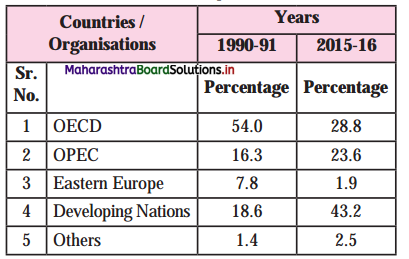
![]()
![]()

